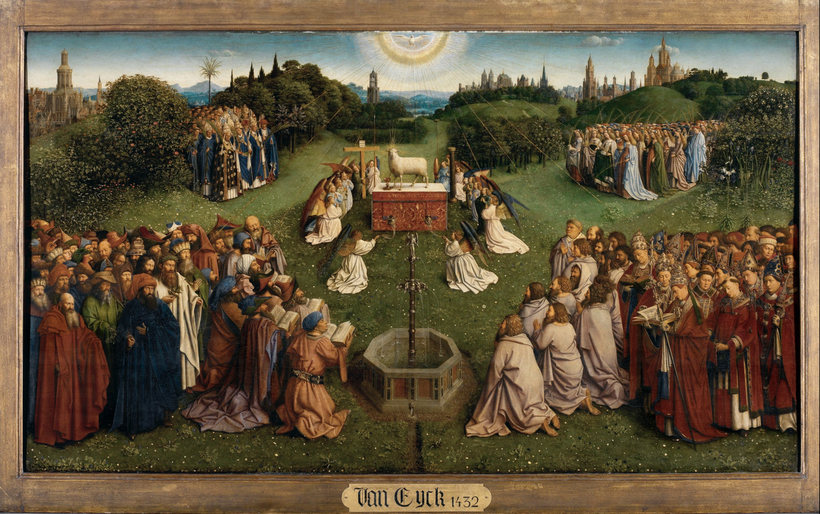It’s the defining artwork of the Catholic Church (according to George Clooney’s character in the 2014 movie The Monuments Men) and as great a work of art as any ever stowed in a salt mine for safekeeping. It is endlessly scrutinized and never wholly comprehended. It’s a cabinet of curiosities, both for the ingenuity of its construction—a set of painted panels unfolding to reveal another set within—and for the way it embodies the career of the enigmatic artist who made it. It is the Adoration of the Mystic Lamb, completed in Ghent in 1432, and the focus of a new show there, “Van Eyck: An Optical Revolution.”
Vasari called Jan van Eyck, who is thought to have lived from 1390 to 1441, “the inventor of oil painting.” Scholars have since softened that assertion, and a different Van Eyck has emerged: a painter who struck a sublime balance between the claims of divine light and natural light, between iconographic patterns and sensual renderings of the way things look and feel.
With Van Eyck, mysteries open onto further mysteries. There’s the mystery of how the altarpiece withstood being taken apart again and again—first by Napoleon’s troops, then by German ones during both World Wars—while also surviving theft, fire, and anti-Catholic riots. There’s the mystery of how it was made: Was it hammered together by Van Eyck’s elder brother, Hubert, and then painted by Jan, as an inscription suggests? There’s the question of where it stands in relation to Van Eyck’s other works: Is it the summation of a tight corpus of masterpieces, or the grand exception in a stream of modest works, some of them since lost or gravely damaged—a daring nude of a woman bathing, for example, and a book of hours, crucial to William Blake in his career as an engraver, that was ravaged by fire in 1904? And then there’s the mystery of how Van Eyck managed to paint it, which deepens when you see the work up close—as on the high-resolution Web site Closer to Van Eyck, which lets you zoom in and scrutinize every strand of hair and pucker of skin.

The Ghent show brings the viewer still closer to Van Eyck by surrounding the newly restored outer panels of the altarpiece with a dozen other works from his hand, as well as works by his contemporaries. And it celebrates his mastery of the emerging science of optics, so well captured in the convex mirror at the center of his painting The Arnolfini Portrait (hanging in London’s National Gallery and deemed too fragile to travel). That mirror is at once a focal point, a piece of optical technology, an eyeball of sorts, and possibly a miniature piece of self-portraiture. It symbolizes Van Eyck’s commitment to realistic painting, which ever since has seen art as a mirror of nature, and exalts the artist’s eye as the greatest optical tool of all. —Paul Elie

